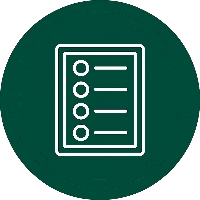When a critical machine on the production line breaks down, everything else slows down with it. Operations halt. Deliveries are delayed. Maintenance teams shift into crisis mode — and often, the cost of fixing the issue is just the beginning.
Unplanned downtime can quickly lead to thousands in lost productivity and missed targets, especially in high-throughput environments where every hour counts. In many cases, these failures were preventable — if only someone had seen them coming.
That’s the goal of predictive maintenance. Instead of reacting to problems after they happen, manufacturers are using real-time data and artificial intelligence to detect early warning signs and plan service work before a breakdown occurs. It’s a shift that’s helping modern factories avoid production losses, lower maintenance costs, and extend the life of their equipment.
Predictive Maintenance Using AI – The Basics
Predictive maintenance is a way to track the actual condition of equipment and schedule repairs only when there’s a real need. It’s a practical step up from time-based maintenance, which often results in unnecessary work, and far more efficient than waiting for something to break.
What makes this strategy effective today is the use of AI. By connecting machines to sensors — which collect data like temperature, pressure, and vibration — manufacturers can monitor performance in real time. That raw data is then processed by AI models trained to recognize patterns that often precede equipment failures.
These systems don’t rely on assumptions or schedules. They learn from past issues and ongoing equipment behavior, helping teams spot small anomalies early — like an unusual vibration in a pump motor or a change in current draw — that often go unnoticed by traditional monitoring.
Here’s how predictive maintenance using AI stands apart:
- It’s condition-based, not schedule-based. Maintenance happens when the equipment actually needs it, not just because it’s time.
- It prevents over-maintaining equipment, which can waste resources and introduce new risks.
- It reduces surprise failures by spotting problems earlier than manual inspections can.
- It improves resource planning, letting teams focus their efforts where it truly matters.
In short, it brings clarity and control to factory maintenance. With predictive maintenance AI systems in place, manufacturers can spend less time guessing — and more time keeping production on track.
AI Predictive Maintenance in Manufacturing – Key Benefits and ROI
Why are more manufacturers turning to AI for predictive maintenance? Because the numbers speak for themselves — and so do the daily pressures on factory teams.
Unexpected breakdowns don’t just cause delays. They derail entire production schedules. Meanwhile, performing maintenance too early wastes time, parts, and labor. That’s why factories across the U.S. are adopting predictive maintenance AI to keep operations running at peak performance, without the guesswork.
By using AI for predictive maintenance, manufacturers can track equipment condition in real time and schedule service at the most cost-effective moment — not too early, and definitely not too late. This approach brings both operational improvements and measurable return on investment.
According to McKinsey, AI-based predictive maintenance can reduce machine downtime by up to 50% and cut maintenance costs by 10–40%. Deloitte also reports that predictive strategies can reduce equipment breakdowns by as much as 70%. These numbers aren’t just impressive — they translate into real savings on the factory floor.
Here are the key benefits U.S. manufacturers are seeing:
- Minimized Unplanned Downtime
AI models can detect subtle signals that precede failure, so maintenance can be done during planned windows. This reduces the risk of sudden stoppages — one of the biggest pain points in manufacturing. - Lower Maintenance Costs
Work is done only when it’s needed. No more over-servicing machines “just in case.” Predictive maintenance optimization ensures parts, tools, and technician hours are used efficiently. - Extended Equipment Lifespan
Catching small issues early helps prevent major damage. AI-based predictive maintenance keeps machines running longer by avoiding breakdowns that lead to costly replacements. - Improved Safety and Productivity
When equipment runs reliably, workers stay safe, and production teams can stay focused. Predictive maintenance with AI removes many of the unknowns that slow down plant operations. - More Accurate Budgeting
With better visibility into when and where issues may arise, manufacturers can plan ahead — from ordering parts to scheduling shifts — instead of reacting to emergencies.
For plants dealing with labor shortages, aging equipment, or high production targets, AI predictive maintenance isn’t just helpful — it’s a practical way to gain control over operations, reduce risk, and improve margins.
Partner With Multishoring’s Manufacturing Software Experts
Our team has delivered tailored software solutions for the manufacturing industry for over a decade — from AI-powered predictive maintenance tools to full system integrations.
Get expert support on the right tools for your factory — from monitoring systems to maintenance platforms.

Get expert support on the right tools for your factory — from monitoring systems to maintenance platforms.

AI and Predictive Maintenance – How It Works on the Factory Floor
So how does predictive maintenance actually work once it’s running inside a manufacturing plant?
The process starts with machines that are already in place. Most modern equipment — and even many retrofitted older machines — can be equipped with sensors that track everything from temperature and vibration to oil pressure and motor current. This is where the foundation of predictive maintenance AI begins: with real-time data.
These sensors collect performance data continuously. Instead of storing it for manual review later, the data is immediately sent to AI models that have been trained to understand how machines behave over time — both when they’re running well and when they’re about to fail.
Using techniques like pattern recognition, anomaly detection, and even deep learning, the system spots unusual changes in equipment behavior. These aren’t just wild guesses — the algorithms rely on a combination of historical failure data and live machine signals to find patterns humans might miss.
Here’s what that process typically looks like:
- Data Collection with IoT Sensors – Vibration, temperature, noise, humidity, and electrical current — all of these can indicate how a machine is performing. These sensors stream data around the clock, creating a live snapshot of every asset on the floor.
- Machine Learning and AI Model Analysis – This data flows into predictive models trained to look for deviations from normal operating conditions. For example, a pump might show increased vibration over time — something the AI picks up as a likely early sign of bearing wear.
- Predictive Alerts and Maintenance Triggers – When a potential failure is detected, the system sends out alerts — often weeks before a breakdown would actually occur. These alerts can automatically trigger a maintenance task or suggest an inspection in the plant’s system.
- Integration with Factory Systems – Predictive maintenance using AI doesn’t sit in a silo. These alerts are typically integrated into CMMS platforms, Power BI dashboards, or ERP tools, so production leads and maintenance planners have full visibility and can act fast.
Let’s say a sensor detects a slow but steady increase in heat and vibration in a motor. The AI model flags this as a developing issue, estimates when the motor might fail, and sends an alert. The maintenance team checks it out, confirms the early wear, and replaces the part during the next scheduled stop — no breakdown, no emergency call, no lost shift.
Through the use of artificial intelligence in predictive maintenance, manufacturing companies can analyze massive amounts of data and turn it into simple decisions — like which machines need attention today, and which ones can run another month without worry.
The result? Fewer surprises. Better planning. And smoother days on the floor.
Implementing AI-Based Predictive Maintenance (Steps & Best Practices)
Getting started with predictive maintenance might sound complicated, especially with AI involved — but the path forward is more structured than it seems.
Most manufacturers don’t need to overhaul their entire maintenance operation overnight. Instead, the best approach is to start small, validate the results, and build from there. Here’s how to begin implementing predictive maintenance with AI in a way that’s realistic and manageable.
1. Identify Critical Assets and Set Clear Goals
Not every machine on the floor needs AI monitoring from day one. Focus on assets that are either expensive to fix, prone to failure, or critical to production flow.
- Think about where breakdowns hurt the most — long downtimes, complex repairs, or production bottlenecks.
- Define what success looks like: Is it fewer breakdowns? Better use of maintenance staff? Improved OEE?
Start where the impact is highest.
2. Install Sensors and Start Data Collection
AI systems need data — and lots of it — to work properly. Most modern equipment already has sensors installed, but older machines may need retrofitting.
- Focus on collecting the right data: temperature, vibration, current, pressure, cycle times, etc.
- Good data = better predictions. If the quality is poor or inconsistent, AI models won’t be reliable.
3. Choose a Platform or Partner
You’ll need tools to manage the incoming data, analyze it, and turn it into predictions. Options range from cloud-based AI platforms to in-house solutions. Many companies also choose to work with technology partners that specialize in predictive analytics and machine integration.
- Platforms from providers like Siemens, IBM, or GE Digital offer pre-built tools for AI for predictive maintenance.
- Working with experienced partners like Multishoring can help customize and integrate these tools into your current systems faster.
4. Train the Model Using Historical Data
AI models learn by analyzing patterns — and that requires data on past equipment behavior, especially failures. If you have historical data, use it. If not, start building it up now.
- Begin with a pilot project on one machine or line.
- Use it to test the AI model’s accuracy, fine-tune the parameters, and reduce false alarms.
This stage is also where predictive maintenance optimization becomes possible. The more the model runs, the more accurate it becomes.
5. Integrate with Your Maintenance Workflow
AI predictions won’t help unless they’re acted on. Make sure insights from your system feed directly into your existing tools, like:
- CMMS platforms that generate work orders automatically
- Dashboards (for example, Power BI) that visualize machine health in real time
The goal is to make AI part of your existing workflow, not a separate system technicians need to chase.
6. Train Staff and Encourage Buy-In
Predictive maintenance with AI might seem unfamiliar to technicians at first. They need time — and results — to trust it.
- Show how early alerts help avoid bigger repairs
- Offer simple training sessions focused on using and responding to alerts
- Involve operators in early pilot tests so they can see the value firsthand
7. Scale Gradually and Keep Improving
Once the pilot works, scale to other machines. Each new asset brings more data — and that improves the model.
- Use feedback to improve accuracy and reduce false positives
- Continue tuning predictions and adjusting thresholds
- Look for ways to connect AI insights to other departments (production, planning, procurement)
Predictive maintenance using AI is not a set-it-and-forget-it solution — it gets better over time as the system learns and your team adapts.
Our Services You Might Find Interesting
Challenges and Considerations in AI Predictive Maintenance
Predictive maintenance with AI can deliver major improvements, but there are challenges to address — especially in traditional manufacturing environments where systems, skills, and processes vary.
Below is a breakdown of the most common obstacles manufacturers face, along with practical solutions to help navigate them.
| Challenge | How to Handle It |
|---|---|
| Data Quality and Gaps | AI models are only as good as the data they’re trained on. Incomplete or inaccurate sensor data can lead to false predictions or no predictions at all. Fix: Start with a data audit. Identify missing signals, verify sensor accuracy, and set up consistent data streams before training the AI. |
| Upfront Costs and ROI Pressure | Installing new sensors, platforms, and AI systems involves upfront investment, and ROI may take time to show. Fix: Begin with a small pilot focused on high-value equipment. Measure avoided downtime or repair costs to build a clear ROI case. |
| Skills and Technical Gaps | Maintenance teams may not have experience with machine learning or advanced analytics. Fix: Train staff on the basics of predictive maintenance systems, or bring in an IT partner to manage setup, integration, and model building. |
| Integration with Legacy Systems | Older machinery and outdated software often don’t connect easily with modern AI platforms. Fix: Use middleware or edge devices to collect and transfer data. Avoid major overhauls by finding tools that work with what’s already in place. |
| Cybersecurity Risks | Sending machine data across networks or to the cloud raises concerns about data security and privacy. Fix: Work closely with IT and cybersecurity teams. Use encrypted communication, user access control, and regular security audits. |
| Change Resistance from Staff | Maintenance technicians may question the reliability of AI recommendations or worry about job changes. Fix: Involve them early. Share results from pilot projects, explain how AI helps — not replaces — their work, and encourage feedback during implementation. |
From Reactive to Proactive – Getting Started
For decades, factory maintenance was about fixing what broke or replacing parts on a schedule, whether they needed it or not. That’s changing — fast.
With AI predictive maintenance, manufacturers no longer have to guess when a machine might fail. They can know. And they can act early.
This shift from reactive to proactive maintenance means fewer breakdowns, lower repair costs, and more predictable operations — all without overloading teams or disrupting production. It’s not a trend; it’s a practical, results-driven strategy that’s already helping plants run smarter.
If you’re working with aging equipment, tight margins, or increasing production demands, now’s the time to take a closer look at where AI could help. Start small. Choose one line, one system, or one machine. Set up a pilot, see the results, and scale from there.
With the right plan and the right support, moving to AI-powered maintenance doesn’t have to be complicated. And the payoff — fewer surprises, stronger performance, and more control over your operation — is well worth it.
At Multishoring, we don’t just build custom software and BI solutions for manufacturing. We help solve real operational problems — with ones tailored to your machines, your systems, and your factory floor.
Whether you need predictive maintenance tools, BI factory dashboards, or integration with your existing CMMS or ERP, our consultants and developers work as part of your team — aligning IT to the needs of your plant.
Ready to explore AI-powered maintenance for your operations?
Let’s talk about a solution built around your business — not just the technology.









